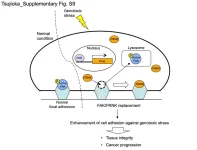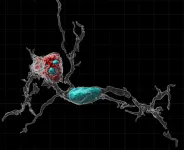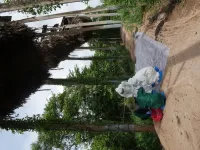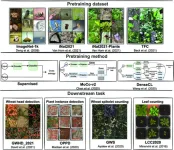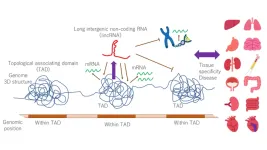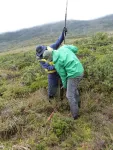(Press-News.org)
Preserving the diversity of forests assures their productivity and potentially increases the accumulation of carbon and nitrogen in the soil, which helps to sustain soil fertility and mitigate global climate change.
That's the main takeaway from a new study that analyzed data from hundreds of plots in Canada's National Forest Inventory to investigate the relationship between tree diversity and changes in soil carbon and nitrogen in natural forests.
Numerous biodiversity-manipulation experiments have collectively suggested that higher tree diversity can lead to greater accumulation of carbon and nitrogen in forest soils. But the new study, published online April 26 in the journal Nature, is the first to show a similar outcome in natural forests, according to the authors.
The researchers used a statistical method called structural equation modeling to assess relationships between tree diversity and soil carbon and nitrogen accumulation. They found that increased tree diversity enhanced soil carbon storage by 30% to 32% and enhanced nitrogen storage by 42% to 50% on a decadal timescale.
"Our study, for the first time, shows the sustained benefits of tree diversity in storing soil carbon and nitrogen in natural forests," said study lead author Xinli Chen, a postdoctoral exchange fellow at U-M's Institute for Global Change Biology and a postdoctoral fellow at the University of Alberta.
"Our results highlight that promoting tree diversity not only increases productivity but also mitigates global climate change and reduces soil degradation. And the size of the diversity dividend is large. It reinforces the importance of biodiversity conservation in forests and will guide the growing efforts to use forests for carbon and nitrogen sequestration."
The researchers calculated changes in soil carbon and nitrogen storage over time by comparing data from two National Forest Inventory sample-plot censuses, one from 2000-2006 and the other from 2008-2017.
They quantified tree diversity as species richness, species evenness, and—on the basis of trees' functional traits—functional diversity.
Species richness is the number of tree species in a sample plot, while species evenness is a measure of the relative abundances of tree species. Functional diversity is the variety of functional traits—such as leaf nitrogen content and adult tree height—of tree species within a community.
The research team found that increasing species evenness from its minimum to its maximum value enhanced carbon storage in the organic soil layer by 30% and nitrogen storage by 42%. Increasing the functional diversity of trees to its maximum value enhanced carbon storage in the soil mineral layer by 32% and nitrogen storage by 50%.
"We find that greater tree diversity is associated with higher soil carbon and nitrogen accumulation, validating inferences from biodiversity-manipulation experiments," said study co-author Peter Reich, a forest ecologist and director of the Institute for Global Change Biology, which is part of U-M's School for Environment and Sustainability.
"A greater diversity of species translates into a mixture of different types of trees with different ways of acquiring and storing biomass—both in live trunks, roots, branches and leaves and in newly dead and decaying plant detritus on and in the soil."
Canada's National Forest Inventory database is based on a network of plots covering much of the country's landmass. The new study analyzed organic soil horizon samples from 361 plots and mineral soil horizon samples from 245 plots.
Those plots are home to various species of fir, maple, birch, spruce, pine, poplar, cedar and hemlock, among other tree types.
Forest soils play an important role in sequestering carbon extracted from planet-warming carbon dioxide gas during photosynthesis. Those soils store at least three times as much carbon as living plants do.
Nitrogen is an essential nutrient that drives carbon assimilation and plant growth in forest ecosystems. Plant diversity is rapidly declining globally, leading to the degradation of ecosystem function, including the function of soils.
The other authors of the Nature study are Anthony Taylor of the University of New Brunswick, Masumi Hisano of the University of Tokyo, Han Chen of Lakehead University, and Scott Chang of the University of Alberta and Zhejiang A&F University.
The research was supported by the Discovery Grants program of the Natural Sciences and Engineering Research Council of Canada, the Canada Foundation for Innovation, the Ontario Research Fund, the Banting Postdoctoral Fellowship, and a grant from the U.S. National Science Foundation's Biological Integration Institutes.
Study abstract: Tree diversity increases decadal forest soil carbon and nitrogen accrual (DOI: 10.1038/s41586-023-05941-9.)
END
Study: Tree diversity increases storage of carbon and nitrogen in forest soils, mitigating climate change
2023-04-26
ELSE PRESS RELEASES FROM THIS DATE:
Hanging on for dear life
2023-04-26
Researchers from Tokyo Medical and Dental University (TMDU) identify a novel mechanism by which cells adhere more strongly to their surrounding matrix in response to stress
Tokyo, Japan – The DNA molecules in our cells can be damaged by various extrinsic and intrinsic factors called genotoxic stressors; persistent and unchecked damage can lead to developing diseases like cancer. Fortunately, our cells don’t sit idly by and let this happen.
In a recent article published in Cell Death & Disease, a team ...
Immune system sculpts rat brains during development
2023-04-26
Researchers have established that biological sex plays a role in determining an individual’s risk of brain disorders. For example, boys are more likely to be diagnosed with behavioral conditions like autism or attention deficit disorder, whereas women are more likely to suffer from anxiety disorders, depression, or migraines. However, experts do not fully understand how sex contributes to brain development, particularly in the context of these diseases. They think, in part, it may have something to do with the differing sizes of certain brain regions.
University ...
One Health surveillance in Viet Nam highlights hotspots for viral disease emergence and calls for One Health action
2023-04-26
HA NOI, Viet Nam (April 26, 2023) – A new study led by the Wildlife Conservation Society (WCS) identified a viral hotspot in Viet Nam where bat roosting sites, bat guano harvesting, and pig farms are all in close proximity. The findings of this collaborative One Health study, described in the latest issue of the journal Viruses, have important implications for public health and wildlife conservation.
The authors say that the collection of guano – commonly used as a fertilizer – if not stopped ...
Breath test can monitor metabolism at home - study
2023-04-26
New research has found that it is possible to capture the impact of a meal on metabolism outside of a lab environment.
Published in the Journal of the International Society of Sports Nutrition and led by researchers at Anglia Ruskin University (ARU) in Cambridge, England, the study evaluated Lumen, which the manufacturers claim is the first device to allow people to monitor metabolic fuel use at home.
The research – the first applied study to investigate the practical use of this handheld breath device – was split into ...
Benchmarking deep-learning methods for more accurate plant-phenotyping
2023-04-26
In crop-breeding, plant phenotyping is the detailed study of a plant’s characteristic ‘visible’ or phenotypic features. It includes counting the number of plants generated by a crossing experiment and grading the features displayed by the offspring or progeny. The progeny with the desirable traits is then crossed to produce the next generation of crops, and the process is repeated to enhance the crop variety. Conventional methods for plant phenotyping typically lack scalability, accuracy, and are immensely labor-intensive. This imposes a certain bottleneck on crop-breeding programs.
However, with technological ...
UH-led research team seeks to improve language learning in bilingual children
2023-04-26
A University of Houston professor and her research team are seeking to improve the lives and education of bilingual children across the country through their research on developmental language disorder.
Anny Castilla-Earls, professor of communication sciences and disorders, was awarded $3.27 million for five years by the National Institute on Deafness and Other Communication Disorders to investigate the relationship between a child’s proficiency in English or Spanish and the language in which they receive treatment for developmental language disorder. Developmental language disorder, or ...
Astronomers image for the first time a black hole expelling a powerful jet
2023-04-26
An international team of scientists led by Dr. LU Rusen from the Shanghai Astronomical Observatory (SHAO) of the Chinese Academy of Sciences has used new millimeter-wavelength observations to produce an image that shows, for the first time, both the ring-like accretion structure around a black hole, where matter falls into the black hole, and the black hole's associated powerful relativistic jet. The source of the images was the central black hole of the prominent radio galaxy Messier 87.
The study was published in Nature on April 26.
The image underlines for the first time the connection between the accretion flow near the central supermassive black hole and the origin ...
LincRNA paints a target on diseased tissues
2023-04-26
Our genetic code includes over 15,000 specific sections that can be made into molecules called lincRNAs. Some of these sections can occur in coiled-up sections of our genome called TADs. LincRNAs derived from TADs appear to act as markers indicating the specific kind of tissue they are within. When something is wrong in these tissues, the markers could help with targeted medical interventions. The team that discovered this novel feature has outlined a way to apply this idea to different diseases and demonstrated it with a heart disease known as hypertrophic cardiomyopathy.
Diseases can affect very specific ...
Prehistoric poo reveals ‘waves’ of extinction in Colombia
2023-04-26
Fungal spores found in dung have revealed that large animals went extinct in two “waves” in the Colombian Andes.
Spores of coprophilous fungi pass through the guts of megafauna (animals over 45kg) as part of their life cycle, so the presence of the spores in sediment samples shows large animals lived in a certain place and time.
The study, by the University of Exeter, found that large animals became locally extinct at Pantano de Monquentiva about 23,000 years ago, and again about 11,000 years ago – with major impacts on ecosystems.
The study used ...
Social vulnerability has direct link to suicide risk, study shows
2023-04-26
More than 45,000 Americans died by suicide in 2020, a 30% increase over 2000, making it the 12th leading cause of death in the U.S. Studies have shown that the social and environmental factors where people live, like exposure to violence and crime, access to quality health care, food insecurity, job opportunities, and air pollution, are connected to suicide rates.
Now, a new research study from the University of Chicago provides more statistical evidence that social determinants of health are tightly linked to suicide risk. The study, published ...
